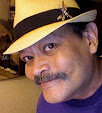| Well, we've had three graduations these past several weeks. First, Amanda, then Amelia, and this past weekend, my niece Madi's graduation open house two states away. We just got back last night from our road trip to Indiana and back. And I see today that eight days have gone by since my last blog entry. So let's go on to the next couple of pages in Dragonfly. Hard to believe almost three months have elapsed since the last Dragonfly post. Here goes. Page 12 Page 13 Here is the National Geographic photograph that inspired this poem (click on it to see a larger version). This image is from the July 1986 issue, a picture taken by Steve McCurry to accompany Arthur Zich's article "Hope and Danger in the Philippines," on the problems faced by newly elected President Corazon Aquino, after the People Power Revolution that drove out Ferdinand Marcos. The photo's caption reads "Muslims of the Moro National Liberation Front pause for prayer while on patrol in Mindanao."
What strikes me today is that the setting for the poem is exactly 25 years ago, a quarter century, and yet the problems that then plagued the Middle East, and by extension the world, continue. Some of the players have changed but much is the same. The opening scene in the poem is a jetplane hijacking by Muslim extremists; that particular tactic culminated in the 9/11 hijackings What struck me then, while I was beginning this poem, is that the Muslims of Mindanao — the Moros — are Shiites who share the same religious culture as the majority of Muslims in Iran and Iraq. They would then share the same important story of the Prophet Muhammad's nephew Husayn being martyred at the Battle of Karbala in 680 AD, so that for the Moros, Husayn would represent the ultimate figure of rebellion against oppression. I then surmised that because of this, the Moros might also revere Iran's Ayatollah Khomeini as the main opponent of the exiled Shah. For the Moros, the Ayatollah's rhetoric of jihad and fatwa might have resonated favorably, as a resource for their own struggle against the Philippine government, against whomever was in charge. The other large theme of this poem is the particularly Malay battle-rage or frenzy called amok. Filipinos "running amok" was a unique military problem for the American forces occupying the Philippines during the Philippine-American War: Filipinos would single-handedly attack entrenched American troops, usually with just a blade, perhaps a machete, and succeed in injuring or killing many. The fight would be at such close quarters that American soldiers found it difficult to fire their rifles effectively without killing Americans or use the bayonets mounted on those rifles. The US Army's solution was the Colt .45 pistol. I recall learning this fact while I was in the US Army and marveling that the army I was in had developed a special weapon specifically to kill my people. Incredible. It's interesting to look at different versions of this poem. In its first appearance in the 1989 Wooster Review, the poem used the words "Moslem" and "Philippine Insurrection." In 1994, the poem as it appeared in Dragonfly still had "Moslem" but the latter phrase had been changed to "Philippine-American War." By 2003, when it was reprinted in the collection Ghost Wars and in the online magazine Our Own Voice, the poem had the more contemporary "Muslim" and "Philippine-American War." Unfortunately, the reprint in Our Own Voice has mistakes; the italicizations and the quotation marks have disappeared. Those should be as given above. (Note: since some people find the word "Moslem" offensive, I have silently emended it to "Muslim" above; Dragonfly used the older usage.) |
|







No comments:
Post a Comment